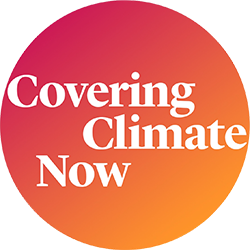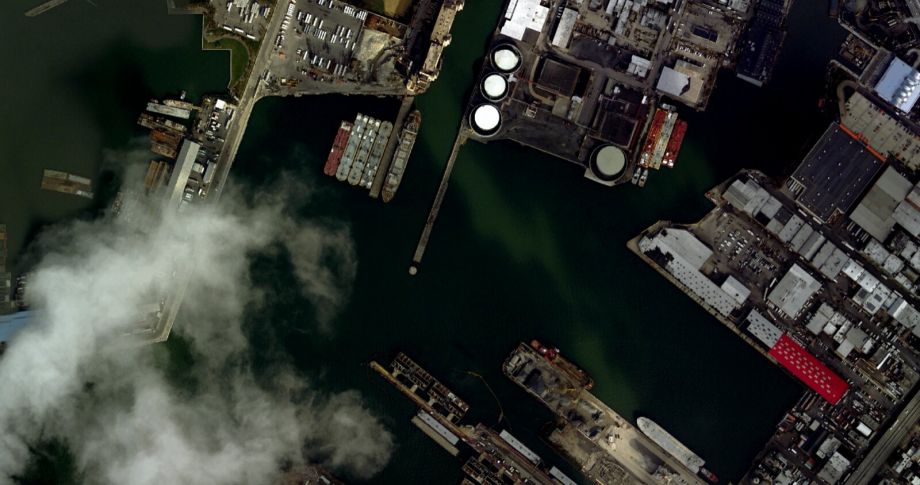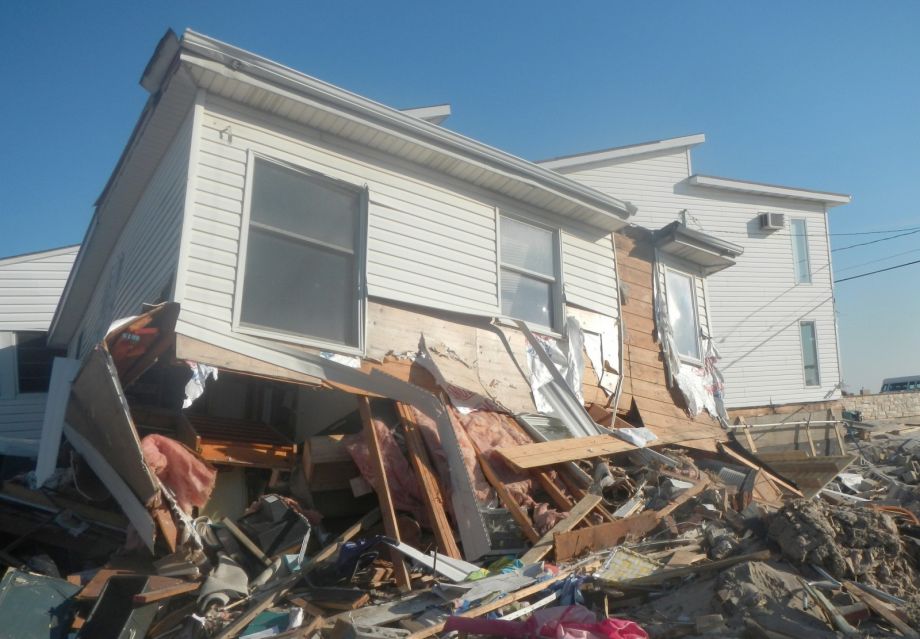Are You A Vanguard? Applications Now Open
The Hunts Point neighborhood in the Bronx.
Photo by Dan DeLuca (CC BY 2.0)
This is your first of three free stories this month. Become a free or sustaining member to read unlimited articles, webinars and ebooks.
Become A MemberEDITOR’S NOTE: This article, by regular Next City contributor Emily Nonko, originally ran in The Guardian. Today New York City is focal point of the conversation on climate change, as the UN Climate Action Summit convenes to discuss “concrete plans” to stop the increase in carbon emissions by 2020, an essential step toward the Paris Agreement’s goal of net-zero emissions by 2050. Next City is a partner in #CoveringClimateNow, a global collaboration of more than 250 news outlets to strengthen coverage of the climate story. Read Next City’s other stories for this initiative here.

Jainey Bavishi is all business as she takes off from Battery Park to walk the perimeter of lower Manhattan. It’s a muggy afternoon, a breeze barely lifting off of New York Harbor, after days of heavy rain. She maneuvers throngs of tourists, construction workers and suits streaming out of office buildings for lunch as she walks north from the waterfront park toward the Brooklyn Bridge.
In a skirt suit and flats, Bavishi fits in among lower Manhattan’s workday hustle. But there’s no one else with a job like hers: director of the New York City’s mayor’s office of resiliency. She is the woman tasked with protecting all 580 miles of New York City shoreline from more frequent and extreme storms and expected sea rise because of the climate crisis.
“We have got a chance to really reimagine the waterfront,” she says, heading underneath FDR Drive past interim flood barriers erected by the city following Hurricane Sandy. There’s an air of promise and forward-thinking in her stride. “I think that’s really exciting,” she exhales.
This walk with Bavishi is, in fact, an exercise in imagining: in March, the mayor, Bill de Blasio, announced an ambitious $10-billion proposal to extend Manhattan’s southern coastline into the East River as far as 500 feet.
Bavishi’s walk from Battery Park almost to the Brooklyn Bridge is the roughly one-mile span proposed for expansion. It includes the Financial District, sparkling residential towers and the luxury mixed-use community Battery Park City, where a one-bedroom condo goes for about $1 million.
Twelve miles north, in Hunts Point in the South Bronx, the waterfront outlines a much different scene. A stench rises from the sidewalks in the summer heat, open garages reveal heaps of auto body parts and cyclists swerve between box trucks that dominate the streets. About 13,000 people live in aging apartment buildings at the center of this peninsula, lined on either side by heavily industrialized waterfront.
Hunts Point residents and activists fought for years to increase access to the waterfront as well as to address longstanding environmental issues. More recently they have engaged with the mayor’s office of resiliency, formed in 2014 to oversee New York City’s $20-billion portfolio of programs intended to make the city more resilient to the climate crisis. In Hunts Point, residents reimagined in a waterfront that addressed longstanding environmental injustices and poverty that persists in the area.
The Hunts Point community spent five years developing a plan for protective waterfront infrastructure doubling as public green space, a “Levee Lab” to study resiliency efforts and create local jobs, and a tri-generation plant creating low-carbon cooling and a micro-grid to supply backup power in emergencies. But around the same time De Blasio introduced his $10-billion proposal, the office of resiliency decided it would not fund that Hunts Point plan, because of the high cost and because Hunts Points residents do not live in the floodplain.
That decision hit this community hard, one of several communities in New York City who are finding they can’t face a future of climate change without quality-of-life issues being addressed first. In preparing for its future, the city would have to confront injustices of its past, and some environmental activists fear the city is not up to the task.
The mayor’s office of resiliency set a goal for holistic resiliency planning across the five boroughs, but there’s a lingering question: how does the city enforce waterfront protection for all, when some of that waterfront is home to billions of dollars of real estate, infrastructure and investment, and other stretches have been neglected for decades?
As the climate crisis promises to lay bare the stark disparities of New York City, the answer has never been more pressing.
For the past five years, the environmental activist Angela Tovar has posted flyers, maps, renderings, artwork and a rally poster that reads “Pollution Isn’t the Solution” all over the South Bronx Community Resiliency Agenda Lab at the cavernous Hunts Point community hub called the Point.
As director of community development at the lab, Tovar is constantly hustling about, running late today because a discussion about the Point’s community-led resiliency plan with the New York representative Alexandria Ocasio-Cortez ran long.
“Not only are we talking about a potential threat of storm surge hitting an environmental justice community, and hitting businesses with toxic chemicals, we are talking about how that would impact [a] food distribution center” that spans 60 acres and serves the entire noertheasern corridor.
Above: Illustration by Raj Dhunna/The Guardian
“Our work on climate justice started a long time ago,” she says. “And it came from an understanding that there is a high volume of toxic substances in this area, which is also vulnerable to storm surge.”
Tovar points to a large map with about 20 red dots marking the peninsula’s waterfront; they represent businesses with high volumes of toxic substances. She identifies the residential blocks between the waterfront as an “environmental justice community where about half the community lives below the poverty line, and there are really serious public health issues we know will be compounded by climate change”.
Tovar then points to a chunk of the peninsula, the entire northeastern half, occupied by the Hunts Point Food Distribution Center, which spans 60 acres and supplies food to the entire northeastern corridor. “Not only are we talking about a potential threat of storm surge hitting an environmental justice community, and hitting businesses with toxic chemicals, we are talking about how that would impact the food distribution center,” she says.
Hurricane Sandy prompted the office of resiliency to focus its attention on protecting the food distribution center. Meanwhile, community organizers such as Tovar had already been advocating for the city to also take stock of the poverty, isolation and longstanding environmental injustices across the peninsula. The office of resiliency ultimately decided to focus on strengthening buildings inside the food distribution center instead of moving ahead on a comprehensive waterfront resiliency plan. (Bavishi says the decision was made because the Hunts Point residential community is not located in the floodplain.)
Her voice strains and head shakes recalling how that news came around the same time De Blasio announced his $10-billion investment in building new land in lower Manhattan. “It felt like a tremendous slap in the face, to be honest,” she says.
Tovar acknowledges that the $10 billion is far from secured, but points out the South Bronx lacks even a promise of funding.
“All we’re saying is, make that same commitment to the most vulnerable communities in New York City,” she says. “Get up on stage, make that commitment and say: ‘Low-income communities and communities of color are disproportionately burdened by climate change.’”
Local activists have moved ahead on smaller projects with more modest amounts of city funding, such as launching a community wifi network resistant to power and internet outages. The Point also runs the Be a Buddy program, which is building a network of local volunteers who learn how to provide resources, aid and immediate support during climate emergencies like heatwaves or storms. “We just have to continue to move on our own,” Tovar says, with a hint of defeat in her voice.
In another borough on another waterfront, another underserved community has come up with their own program to train residents to help one another. It’s called Local Leaders, a 10-week emergency preparedness training run by the not-for-profit Red Hook Initiative (RHI) out of a converted warehouse a few blocks from the Gowanus Expressway, in Red Hook, Brooklyn.
Unlike the South Bronx, Hurricane Sandy devastated Red Hook, transforming RHI into da e facto recovery headquarters. The thousands of residents seeking help were primarily public housing residents — this neighborhood has the second-highest concentration of public housing in the city. Red Hook embodies perhaps the greatest challenge facing New York as it braces for the climate crisis: nearly one-fifth of all housing units within New York’s floodplain are public housing, and the city’s public housing agency struggles to provide even basic services to residents.
Tevina Willis moved into the sprawling public housing complex about a decade ago. During Sandy, she and her neighbors ran up and down stairs, hauling water and spreading information about available resources. She was one of the first graduates of Local Leaders after RHI initiated it in 2013 to empower residents with emergency preparedness tactics such as CPR and conflict resolution; now she facilitates incoming groups. “Local Leaders further connected me to my neighbors,” Willis says, “And it took off from there.”
During an August block party hosted by RHI, a conversation with Willis about resiliency kept returning to housing. “Our electricity constantly goes out, every other day there’s an electrical fire in someone’s apartment,” she details over pop and rap music blasting from the DJ booth. “A lot of our tenants experience gas outages.” She points to a resident who recently went without gas for six months.

This aerial image of Red Hook, Brooklyn, a neighborhood surrounded on three sides by water, was taken on November 16, 2012, 19 days after Hurricane Sandy first struck the NYC metro. (Image provided by NOAA; Photo by Mapbox, CC BY 2.0)
Willis is helping spearhead the next phase for trained Local Leaders: “a social justice and community organizing campaign to fight for policy change” with a focus on improving public housing. “We need resiliency inside our apartments,” she says.
On a quieter day, RHI’s chief strategy officer, Javier Lopez, spoke about the larger resiliency vision for the neighborhood. While the city has installed some interim flood protections since Sandy, a larger plan to install floodwalls, raise streets and improve drainage to protect housing has yet to be implemented. Like Willis, Lopez struggles to reconcile the planning process with the glaring needs of public housing residents. “It’s hard to project the future when the present hasn’t been addressed,” he says.
He spoke of a divide between low-income, marginalized residents and the scientific, architectural and urban planning community advancing resiliency plans. “Sometimes we walk into these meetings and the architects and scientists are coming in at a 10, and we’re at a two,” he says.
“No one from the resiliency world has had the awareness to take into account that neighborhoods have faced structural racism and various forms of disinvestment,” he continues. “There are voices missing, there are areas of concern, there hasn’t been a restoration of what was lost since Sandy.”
Along our lower Manhattan walk, and again in a quick telephone conversation, I ask Bavishi how she weighs the needs of different waterfront communities in resiliency planning. “An incredible amount of community engagement,” she says. “Our goal is to be thoughtful and inclusive, recognizing there is no silver bullet and there is no one-size-fits-all solution. We have to work with communities to figure out the right solutions for particular neighborhoods.”
She points to an inter-agency plan developed in Edgemere, in Rockaway, Queens. Edgemere has been called one of the most neglected neighborhoods in New York City and is particularly vulnerable to the climate crisis because it’s sandwiched between Jamaica Bay and the Atlantic Ocean. During Sandy, flooding from both waterfronts — one lined with a defunct landfill, the other a city-owned wasteland — debilitated the neighborhood.

From November 2012: A house in the Rockaways, Queens, destroyed by Sandy. (Photo by Jim.Henderson, CC0 1.0)
“We were able to engage communities in thinking holistically about what would make their neighborhood more resilient,” Bavishi says. The resulting plan includes buying hurricane-destroyed houses to turn into parks, transit upgrades, raising homes and the shoreline, building a new mixed-use complex and improving the public housing lining the bay.
Sonia Moise watched the calm waters of the bay meet the fierce waves of the ocean from her bedroom window in Edgemere the night of Sandy.
The promise of Edgemere as a more resilient neighborhood is overshadowed by her seven-year struggle to recover from that day. “There’s no amount of people who complain like we do about [recovery] work not being done the right way,” she says. “I honestly believe we were treated the absolute worst because of location.”
Outside of her three-story home hoisted atop a slab of concrete, she mentioned how long it took to grow backyard grass because the property was built atop rocks and sand. This spring she wrapped a storm-proofing renovation, funded by her savings as well as the city’s post-Sandy rebuilding program, Build it Back. But the saga isn’t over: she recently hired a lawyer to dispute the quality of work from Build it Back, which she feels will not sufficiently protect her from the next storm.
“We need to feel we’re safe,” she says of her community’s lingering trauma recovering from Sandy. But there’s a larger threat beyond the next storm: Edgemere will be one of the first New York neighborhoods made uninhabitable by the climate crisis. There’s already a division emerging on Moise’s block: homes with raised elevation — like her own — and those still at ground level. “The people who haven’t raised their houses know they won’t be able to stay,” she says.
The city offered to buy Moise’s property following Sandy, but she declined. “I don’t trust the city, that they’d give the money you want for your house,” she says. Would she consider selling if she knew she would get a fair payment? “Probably not,” she says, considering the grievances built up during the recovery process. “I have a disdain for the city.”
So Moise will stay, as her neighborhood is both transformed by the climate crisis and the city’s efforts to protect it. On the cusp of such transformation, there’s a quiet, almost eerie atmosphere walking the streets — even a level of disbelief that Edgemere does, in fact, belongs to the same city as lower Manhattan.
When De Blasio announced his ambitious proposal to expand lower Manhattan, he listed the reasons it was worth saving: home to a half-million jobs, 90,000 residents, the nexus of nearly all the city’s subway lines. He left out that the city and private sector have heavily invested in this neighborhood since the early 1700s, when it emerged as a financial hub, as other waterfronts became places to house poor New Yorkers, often alongside toxic industrial sites.
Bavishi’s goal to holistically address it all is daunting, if not impossible. Funding sources to implement many of the city’s resiliency plans, including lower Manhattan’s, are uncertain. Implementation in neighborhoods such as Red Hook has taken longer than residents expected. Crucial city agencies such as the New York City Housing Authority, which oversees public housing along the floodplain, lack its own vision and funding for resiliency. And, as Tovar mentioned in the resiliency lab, De Blasio still has yet to get on a stage and acknowledge that low-income communities are disproportionately burdened by the climate crisis.
Bavishi ultimately acknowledges the office of and resiliency does not have the capability to address all the longstanding concerns of marginalized communities. “There’s an urgency to climate challenges we’re facing and we want to take that seriously,” she tells me over the phone. “We also want to make sure we’re not raising expectations for other solutions that are out of sync with the resources we have.”
So New York is left to see how its most vulnerable residents will survive as the city’s shorelines are transformed — when the ambitious resiliency plans fall through, when storm-proofing can’t address day-to-day needs such as safer housing.
“Having an exciting, bold vision is not enough,” Tovar says of the Hunts Point resiliency plan, though she could be talking about the rest of the city. “I hope the city comes back to the table to think big and do something unprecedented, because we’re New York City. But how do we encourage them to do that?”

Emily Nonko is a social justice and solutions-oriented reporter based in Brooklyn, New York. She covers a range of topics for Next City, including arts and culture, housing, movement building and transit.
Follow Emily .(JavaScript must be enabled to view this email address)

20th Anniversary Solutions of the Year magazine